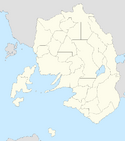The Islands (Urcea): Difference between revisions
mNo edit summary |
mNo edit summary |
||
| Line 1: | Line 1: | ||
{{Template:Urcea geography sidebar}} | {{Template:Urcea geography sidebar}} | ||
'''The Islands''' is a term referring to the region of [[Urcea]] including the provinces of [[North Crotona]], [[South Crotona]], [[Tromarine]], and [[Halfway]]. Consisting of some of Urcea's most geographically distinct and latest acquired territories, the Islands reflect a diverse array of cultural and historical influences with primarily [[Ancient Istroyan civilization|Istroyan]], [[Latinic people|Latinic]] backgrounds though significantly impacted by the influence of [[Audonia|Audonian]] civilization. | '''The Islands''' is a term referring to the region of [[Urcea]] including the provinces of [[North Crotona]], [[South Crotona]], [[Tromarine]], and [[Halfway]]. Consisting of some of Urcea's most geographically distinct and latest acquired territories, the Islands reflect a diverse array of cultural and historical influences with primarily [[Ancient Istroyan civilization|Istroyan]], [[Latinic people|Latinic]] backgrounds though significantly impacted by the influence of [[Audonia|Audonian]] civilization. The Islands are occasionally contested to be parts of [[Sarpedon]] along with [[Urlazio]], but a majority consensus of scholars place Tromarine and [[Crotona]] in [[Levantia]] while placing Halfway in Sarpedon. | ||
Within Urcea, the islands were unified as a single entity under the [[Kingdom of Crotona]], which existed as a [[Government_of_Urcea#Crownland|crownland]] of [[Urcea]] from 1660 to 1892. During that time, the three islands became closely associated with one another not only administratively but also culturally and politically. Following the [[Administrative Reorganization Act of 1892]], the Islands took their current provincial form. | |||
The Islands are commonly known for their ancient cities, some of whom were the first colonies of [[Adonerum]] and were important cities in early [[Great Levantia]]. | |||
==Geography== | ==Geography== | ||
| Line 6: | Line 10: | ||
==History== | ==History== | ||
{{Main|History of Crotona|History of Halfway|History of Tromarine}} | {{Main|History of Crotona|History of Halfway|History of Tromarine}} | ||
Between [[1782]] and [[1943]], [[Caphiria]] claimed all of the islands as "natural parts of Caphiria as insular regions of [[Sarpedon]]". Their claim was abandoned as part of the [[Treaty of Kartika]]. | |||
[[Category:Geography of Urcea]] | [[Category:Geography of Urcea]] | ||
[[Category:Geography]] | [[Category:Geography]] | ||
[[Category:IXWB]] | [[Category:IXWB]] | ||
Revision as of 09:25, 18 April 2022
| This article is part of a series on the |
| Geography of Urcea |
|---|
 |
The Islands is a term referring to the region of Urcea including the provinces of North Crotona, South Crotona, Tromarine, and Halfway. Consisting of some of Urcea's most geographically distinct and latest acquired territories, the Islands reflect a diverse array of cultural and historical influences with primarily Istroyan, Latinic backgrounds though significantly impacted by the influence of Audonian civilization. The Islands are occasionally contested to be parts of Sarpedon along with Urlazio, but a majority consensus of scholars place Tromarine and Crotona in Levantia while placing Halfway in Sarpedon.
Within Urcea, the islands were unified as a single entity under the Kingdom of Crotona, which existed as a crownland of Urcea from 1660 to 1892. During that time, the three islands became closely associated with one another not only administratively but also culturally and politically. Following the Administrative Reorganization Act of 1892, the Islands took their current provincial form.
The Islands are commonly known for their ancient cities, some of whom were the first colonies of Adonerum and were important cities in early Great Levantia.
Geography
History
Between 1782 and 1943, Caphiria claimed all of the islands as "natural parts of Caphiria as insular regions of Sarpedon". Their claim was abandoned as part of the Treaty of Kartika.